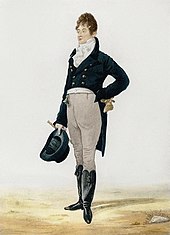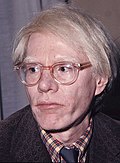Dandy (mode)
 For alternative betydninger, se Dandy. (Se også artikler, som begynder med Dandy)
For alternative betydninger, se Dandy. (Se også artikler, som begynder med Dandy)
Dandy er et engelsk ord for 'spradebasse', 'laps' eller 'modeløve', altså en let nedsættende betegnelse på en mand, som har overdrevent elegante og moderne klæder og gerne er selvoptaget og ødsel.
Baggrund og brug

Ordet kom til i 1700-tallet i London og Paris, med lidt forskellige fremtoninger. I London er en dandy en mand fra middelklassen som forsøger at snyde sine omgivelser til at tro at han tilhører aristokratiet med sin klædestil og elegance. En vis overdrivelse i tøjet og i sin opførsel blev sagt at være et typisk kendetegn på en dandy. Dandy blev ofte benyttet synonymt med snob.

Allerede mod slutningen af 1700-tallet anslog dandyen tonen i moden. Et af de vigtigste indslag i en dandys tøjstil var den sorte jaket og høj hat. En rigtig dandy blev karakteriseret af koldblodighed, høvisk næsvished, nonchalance, kold sarkasme, ironi, god smag og elegance.
Joachim Murat (1767–1815), en marschal som var gift med kejser Napoleon 1.s yngre søster Caroline Bonaparte og i 1808 blev udnævnt af Napoleon til konge af Napoli, blev i England omtalt som The Dandy King på grund af hans forkærlighed for pynt og dekorationer.[1]
På engelsk har dandy også betydningen 'finfint', 'toppen'» (hverdagssprog siden cirka 1785 ifølge Dictionary of American slang). Ordet dandy forekommer også i en populær amerikansk folkemelodi fra midten af 1700-tallet - Yankee Doodle Dandy. I 1942 vandt skuespilleren James Cagney en Oscar for sine rolle i filmen med samme navn.
Eksempler
- Den første kendte dandy var George Bryan Brummell (1778 - 1840), kendt som Beau Brummell. Han var god ven af prinsen af Wales, den senere kong Georg 4. af Storbritannien.
- Jacques d'Adelswärd-Fersen
- Oscar Wilde
- Lord Byron
- Charles Baudelaire
- Andy Warhol
- Gabriele d'Annunzio
- Noël Coward
- Edward Hughes Ball Hughes
- Beau Nash
- The Oxford Wits
- Thomas Raikes
- William B. Travis
- Abraham Valdelomar
- Sebastian Horsley
Galleri
Wolfgang Amadeus Mozart (1756-1791), østerrigsk komponist
Lord Byron (1788-1824), engelsk digter
Benjamin Disraeli (1804-1881), britisk statsminister
Charles Baudelaire (1821-1867), fransk digter
Oscar Wilde (1854-1900), irsk digter
Andy Warhol (1928–1987), amerikansk kunstikon
Litteratur
- Barbey d'Aurevilly, Jules: Of Dandyism and of George Brummell. Translated by Douglas Ainslie. New York: PAJ Publications, 1988.
- Carassus, Émile: Le Mythe du Dandy 1971.
- Espartaco Carlos: Eduardo Sanguinetti: The Experience of Limits,(Ediciones de Arte Gaglianone, first published 1989) ISBN 950-9004-98-7.
- Carlyle, Thomas: Sartor Resartus. In A Carlyle Reader: Selections from the Writings of Thomas Carlyle. Edited by G.B. Tennyson. London: Cambridge University Press, 1984.
- Jesse, Captain William: The Life of Beau Brummell. London: The Navarre Society Limited, 1927.
- Lytton, Edward Bulwer, Lord Lytton: Pelham or the Adventures of a Gentleman. Edited by Jerome McGann. Lincoln: University of Nebraska Press, 1972.
- Moers, Ellen: The Dandy: Brummell to Beerbohm. London: Secker and Warburg, 1960.
- Murray, Venetia: An Elegant Madness: High Society in Regency England. New York: Viking, 1998.
- Nicolay, Claire: Origins and Reception of Regency Dandyism: Brummell to Baudelaire. Ph. D. diss., Loyola U of Chicago, 1998.
- Prevost, John C.: Le Dandysme en France (1817–1839) (Geneva and Paris) 1957.
- Rodgers, Nigel: The Dandy: Peacock or Enigma? (London) 2012
- Stanton, Domna: The Aristocrat as Art 1980.
- Wharton, Grace and Philip: Wits and Beaux of Society. New York: Harper and Brothers, 1861.
Se også
- Snob
- Macaroni
- Yankee Doodle
- Incroyables og merveilleuses, dandy efter den franske revolution
- Den store Gatsby
Referencer
- ^ John C. Prevost; Le Dandysme en France (1817-1839), Genève og Paris (1957).
Eksterne henvisninger
- La Loge D'Apollon
- El Dandy.net (in spanish)
- "Bohemianism and Counter-Culture": The Dandy Arkiveret 22. juli 2016 hos Wayback Machine
- Il Dandy (in Italian)
- Dandyism.net
- "The Dandy" Arkiveret 19. januar 2005 hos Wayback Machine
- Dandies and Dandies by Max Beerbohm
- "Duchamp is Dandy" by Michael Beyer
- Shubow, Justin. "The Prince and the Dandy": a review of Nicholas Antongiavanni's The Suit: A Machiavellian Approach to Men's Style. The Claremont Review of Books, Fall 2006.
- Walter Thornbury, Dandysme.eu "London Parks: IV. Hyde Park", Belgravia: A London Magazine 1868
|
Medier brugt på denne side
Benjamin Disraeli painted by Francis Grant in 1852 when the subject was 48, but depicting him as a young man in the costume of the 1820s.
This posthumous portrait of Wolfgang Amadeus Mozart was painted by Barbara Kraft at the request of Joseph Sonnleithner in 1819, long after Mozart died. Sonnleithner, who was making a "collection of portraits in oils of well-known composers" (Deutsch) wrote to Mozart's still-living sister Maria Anna ("Nannerl"), asking her to lend a picture to Kraft (a well-known artist working in Salzburg). Here is part of Nannerl's reply:
- ... [her friend ] Councillor von Drossdick ... sent the artist to me to see all 3 [of my] pictures [of Mozart], the one that was painted when he came back from the Italian journey is the oldest, he was then just 16 years old, but as he had just got up from a serious illness, the picture looks sickly and very yellow; the picture in the family portrait when he was 22 years old is very good, and the miniature, when he was 26 years old, is the most recent I have, I therefore shewed this one to the painter first; it seemed to me from her silence that is would not be very easy to enlarge it, I therefore had to shew her the family portrait and the other one, too. ... she wants to take her copy from the family portrait and introduce only those features from the small picture which make him look somewhat older than in the big picture."
Deutsch identifies the three pictures as:
- "Perhaps" the portrait by Knoller, Milan 1773. [1]
- The family portrait by della Croce.
- A lost small version of the famous portrait by Joseph Lange.
Portrait of the American artist Andy Warhol at his exhibition dedicated to Black transvestites in the US. Ferrara, November 1975
George "Beau" Brummell, watercolor by Richard Dighton (1805)
Caricature of Beau Brummell done as a print by Robert Dighton, 1805.Three quarter length portrait of Oscar Wilde(en) by Napoleon Sarony(en). 1 photographic print on card mount : albumen.













